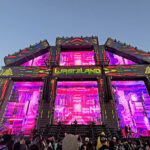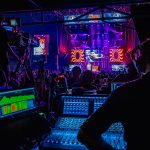The Sixth Annual Euphoria Music & Camping Festival
On any other day at Carson Creek Ranch, one might hear crickets chirping in the grove of pecan trees, while cattle grazed and horses neighed under the hot Austin, TX sun. But for four days in April, its 60 acres of fields along the banks of the Colorado River were transformed into an entertainment venue with the Euphoria Music & Camping Festival.
The fest featured three performance stages of EDM, hip-hop and indie music, while around the grounds were environmental workshops, live painters, an art village and whimsical happenings to enhance the experience. New this year was a site set up for weddings, with “glamping” honeymoon suites as part of the package.

Building from Scratch
Unlike outdoor shed shows, the Euphoria Festival site was just a field, an empty canvas. “There’s nothing there — everything is built for the festival and has to be brought in,” says Toucan Productions president Robin Alvis. “Not only stages and roofs but generators to fencing, water, power, Porta Johns, everything.”
The first Euphoria took place at a racetrack in 2012. The next two years, it ran for two days in an amphitheater. It found a new home at the ranch the third year, and camping was added.
Toucan Productions has supplied production for Euphoria since 2014, when it featured just one stage. This year, Toucan provided lighting, video and lasers on the Euphoria stage; the roof, stage, lighting, video and lasers for the Elements stage; and lighting for the Dragon Fly and Village Bowl stages.
Toucan trucked in its own gear from its Oklahoma City base, working with Houston-based GVP Media to supplement some video and Oklahoma City’s Laserwolf FX for lasers.
Production manager/lighting designer Brad Meyers worked with the Euphoria festival team under CEO/producer Mitch Morales to design the video and lighting package for each stage, wrangling the lighting requirements for each artist into the rig.
“Every artist sends their rider to the festival stating their specific needs for lighting, video and lasers,” Meyers says. “Typically, we pay the most attention to the needs of the artists playing after sunset, with emphasis on the headlining artist for each day.”
This year’s headlining artists were The Disco Biscuits, Pretty Lights, Chromeo, Wiz Khalifa, Alesso and Oliver Heldens. All lights were available for all artists, except for the floor lights, floor video walls and the laser package, which were dedicated exclusively for headliner use.

Lighting and Video
Regarding video walls, Meyers prefers multiple smaller walls arranged creatively to allow lighting fixtures to punch through the video more effectively. “But to accommodate the artists, I had to use a large 16:9 format rear video wall. To punch through such a large video wall, I needed fixtures powerful enough, which ended up being 24 Vari-Lite VL4000 spots, 77 Elation Platinum Beam Extremes and 24 Robe Spiiders as the wash fixtures.”
Other lights rounding out the rigs were 28 Martin MAC Auras, 24 Martin Atomic 3000 Strobes, seven Chauvet Professional Rogue R2 LED Wash, 36 Blizzard Lighting ToughPAR Quadra, 24 Elation Rayzor Q7 LED, 16 Philips Showline Nitro Strobes and eight Chauvet Strike 4 LED Blinders.
Two Resolume media servers provided content for the LED walls, which are made from 425 LED panels in 10mm, 9mm and 6mm sizes. The 14 24W Kvant OPSL lasers offered extra dimensional effects.
To assist LDs with programming, Meyers sets up an “intricate” punt page for any who choose to use it, or, in the rare instance, for artists without a lighting programmer.

“I typically work closely with the LDs and send them complete plots and patch information as early as possible so that we can receive approval from their team, and they are able to program in advance using previz software,” Meyers says. “That way, the headliner’s lighting designers can come in the night before — usually between 2 a.m. to 6 a.m. — and test and adjust their advanced programming without having to start from scratch.”
Lighting consoles involved included a few grandMA2 Full and Lite desks; and Avolites consoles including the Sapphire Touch, a couple of Tiger Touch II and the Sapphire Quartz.
With all bases covered, the main logistical challenge is the typical one in an outdoor show: the weather. “It’s only challenging if it rains,” says Toucan Productions’ director of operations Chauncy Harris. “But we have skilled drivers who can get a tractor and trailer pretty much anywhere, so that helps!
“Music Festivals can be challenging,” Harris adds, “but we’ve got the right people organizing and handling our end. Also important to the process is that our team works so well and easily with the festival staff, which in the end makes everyone happy.”


